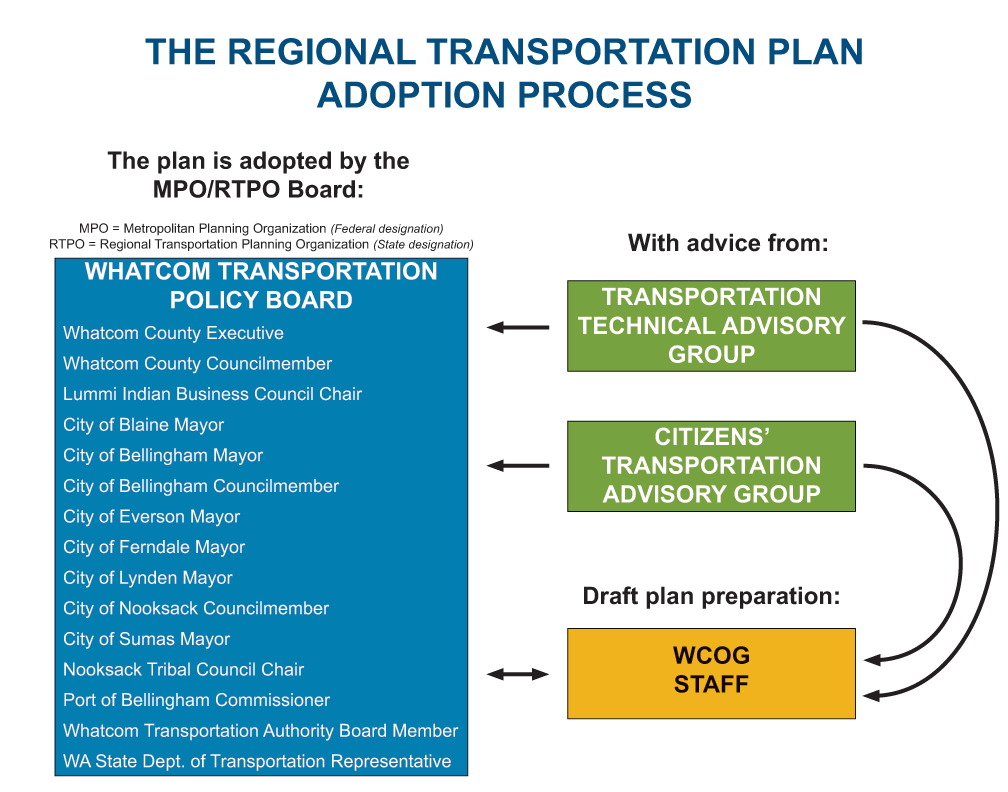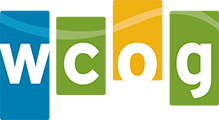Welcome to Whatcom Mobility 2040, the Whatcom region’s combined metropolitan and regional transportation plan. This section provides an overview of state and federally-required transportation planning and the role that the Whatcom Council of Governments (WCOG) plays in satisfying those requirements.
What is the Whatcom Council of Governments?
WCOG is a regional planning conference: WCOG was created in 1966 pursuant to RCW 36.64.080, the state law enabling the creation of “regional planning conferences,” more commonly known in Washington as “councils of governments.” In accordance with this legislation, WCOG serves as a regional planning forum for the various jurisdictions in Whatcom County, including the seven cities, Whatcom County government, the Port of Bellingham, the Whatcom Transportation Authority (WTA), the Lummi Nation and others. The state’s objective under this legislation is to provide a framework for adjacent and nearby jurisdictions to collaborate on problems that are more effectively addressed as a region.
WCOG is a metropolitan planning organization (MPO): By 1980, the City of Bellingham’s population exceeded 50,000, and accordingly, the federal government designated the City and its environs an “urbanized area.” That designation gave Bellingham access to federal transportation funding, but also required that the federally prescribed transportation planning process be carried out. In order to meet these requirements, Governor John Spellman designated WCOG as the MPO for the Bellingham Urbanized Area in 1982. (Federal law regarding metropolitan planning is found at 23 U.S. Code § 134)
WCOG is a regional transportation planning organization (RTPO): In 1990, following passage of Washington’s Growth Management Act (GMA), WCOG was designated as Whatcom County’s RTPO. (The responsibilities of RTPOs under GMA are contained in RCW 47.80.) As such, WCOG is required to carry out a regional transportation planning process for all of Whatcom County, not just the Bellingham Urbanized Area.
While there are certain differences between the MPO and RTPO planning processes, they are similar enough that WCOG has integrated them into a unified process governed by a combined MPO/RTPO board known as the Whatcom Transportation Policy Board. As a result, Whatcom Mobility 2040 serves as the long-range transportation plan for all of Whatcom County: its urbanized core in and around Bellingham, its smaller cities, and the County’s vast rural areas.
Figure 1: The Regional Transportation Plan Adoption Process

Whatcom Mobility 2040: the long-range transportation plan for our region
While the unified planning process that WCOG carries out to meet its responsibilities as both an RTPO and MPO is continuous, updates to the region’s long-range transportation plan are required every five years. Thus, Whatcom Mobility 2040 is a snapshot as of 2017 that describes:
- The regional transportation system as it exists and functions today
- The region’s transportation goals, i.e., the outcomes we expect from our investments in transportation projects, programs and services
- The forecast for transportation demand that our region will experience over the next 23 years, and
- Our collaboratively-developed regional strategy for advancing our transportation goals through projects, programs, collaboration and public engagement – and how to pay for it.
Whatcom Mobility 2040 was unanimously adopted by the Whatcom Transportation Policy Board on June 14, 2017, and will remain in effect until June of 2022. Even with the plan complete, though, WCOG’s federal and state-mandated transportation planning process continues. System performance monitoring, collaborative identification of needs and solutions, and stakeholder engagement continue to inform policy and investment decisions. WCOG also continues to work with and assist its numerous members by providing technical assistance, including travel demand modeling and project prioritization.
Why does WCOG prepare a regional and metropolitan transportation plan?
A comprehensive, cooperative and continuing process is required for an urbanized area to be eligible for federal transportation funding. This “3C” process – of which this plan is a product – is the mechanism for aligning future investments of public funds with communities’ priorities, financial capabilities, land-use plans and population characteristics. More important than it being a statutory requirement, though, is that preparing a long-range transportation plan enables the region to better understand its needs, take stock of its assets, acknowledge its deficiencies and chart a course to improving mobility for everyone who travels within or through Whatcom County.
Relationship to sub-regional planning
Whatcom County and its seven cities all engage in transportation planning as part of their GMA-mandated comprehensive planning responsibilities, and the Lummi Nation and Nooksack Tribe carry out similar processes. The Whatcom Transportation Authority (WTA) – which operates the region’s bus transit and ridesharing services – conducts a different, but extremely complex, planning process. The Port of Bellingham is also engaged in transportation planning to ensure access to its numerous facilities throughout Whatcom County, which include various marinas, industrial sites and Bellingham International Airport. Through their membership on the Whatcom Transportation Policy Board, these entities’ transportation planning processes inform the regional planning process conducted by WCOG, and vice versa.
Relationship to state planning
Metropolitan and regional planning conducted by the various MPOs and RTPOs in the State of Washington – including that of WCOG – is integrated with the state’s own transportation planning process, which is the responsibility of the Washington State Department of Transportation (WSDOT). One example of this is the alignment of WCOG’s six-year regional Transportation Improvement Program (TIP) – a list of upcoming transportation projects developed in cooperation with WSDOT that includes all federally and state-funded regional projects – with the Statewide TIP. Another example is the collaboration among WSDOT, WCOG and its member jurisdictions on system evaluation and planning. The integration of regional and statewide planning is also reflected in WSDOT’s membership on the Whatcom Transportation Policy Board.
Relationship to citizens
Good planning also requires the involvement of individual citizens, businesses, non-governmental organizations and other community groups and constituencies. This is partially facilitated through elected officials’ participation on the Whatcom Transportation Policy Board, where they represent the interests of their constituents. A more direct role in regional transportation planning is played by the members of the Citizens’ Transportation Advisory Group (CTAG). The members of CTAG are private citizens appointed to represent the concerns of the community in which they live (city, reservation or unincorporated Whatcom County) or certain groups who often have special transportation needs, such as senior citizens, disabled persons and college students.
The most basic way for citizens to participate in the regional and metropolitan transportation planning process is to attend meetings of the Whatcom Transportation Policy Board and/or share their concerns and ideas directly with the local elected officials serving on it. Forums held in conjunction with proposed transportation initiatives are also good opportunities for citizens to have their voices heard. Citizens can also stay abreast of the work being conducted by WCOG and its member jurisdictions and agencies through their websites, all of which are linked to WCOG’s website, www.wcog.org. If you have questions about how you can engage in the regional transportation planning process, please see WCOG’s Public Participation Plan.
